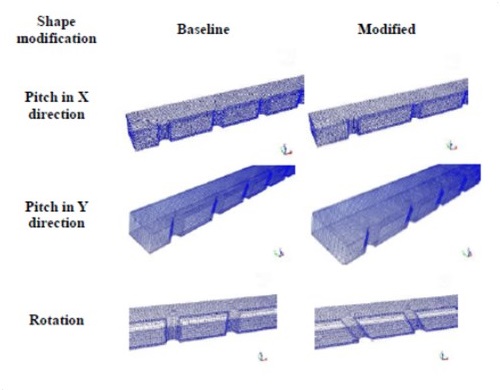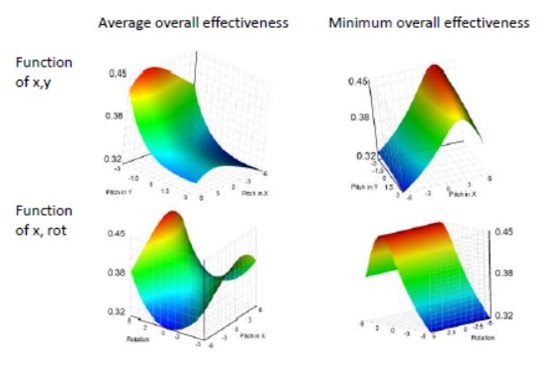Goal Driven Shape Optimisation for Conjugate Heat Transfer in an Effusion Cooled Wall
Full coverage effusion cooling was numerically investigated by means of conjugate heat transfer (CHT) computational fluid dynamics (CFD) for an array of effusion cooling holes in order to maximise the overall cooling effectiveness for a fixed coolant mass flow rate G, kg/sm2. The baseline case study consisted of a 152x152x6.35mm perforated wall with a 300 K, 0.18 kg/sm2 coolant flow through a square array of 90o effusion holes. The plate was mounted in a 770 K duct crossflow. The numerical model was validated against the experimental work of Andrews et al. (1990) and showed a maximum disagreement between the prediction and the experimental data of 3%. The effects of three geometrical parameters, i.e. the inclination of the holes, the pitch in X direction and the pitch in Y direction, on the overall cooling effectiveness were investigated without varying the coolant flow rate.
The inclination of the effusion holes was varied between -33o and +33o from the plane of the plate, while the pitch in both directions was varied between 10.64mm and 19.76mm.
The numerical investigation was performed using the commercial software ANSYS Workbench following a design of experiments approach. The geometrical modifications were obtained automatically in the CFD solver ANSYS Fluent for each design point by means of the RBF Morph software. This avoided the manual modification of the geometry and the subsequent mesh generation.

The optimised configuration was obtained considering the maximisation of the average overall cooling effectiveness as a goal and a chosen minimum value for the local cooling effectiveness of 0.4 as the constraint. The results showed that the inclination of the effusion holes and the pitch in the Y direction have a greater impact on the cooling effectiveness than the pitch in the X direction, up to 17%, 28% and 5% from the baseline, respectively, within the range of values W2Q<considered. An optimal combination of the three parameters was determined.

Click here for more information.
